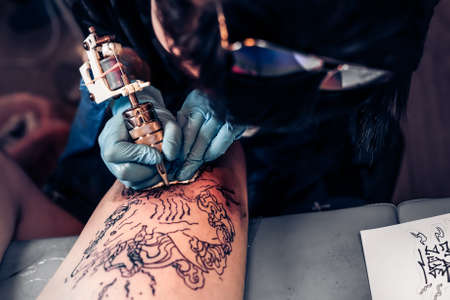Overview of Laser Tattoo Removal in the UK
Laser tattoo removal has seen a marked rise in demand across the United Kingdom, reflecting a broader shift within the British aesthetic industry. With tattoos becoming more mainstream over the past two decades, an increasing number of individuals are now seeking safe and effective solutions to remove unwanted ink. This surge is not only driven by personal preference changes, but also by evolving workplace standards and lifestyle shifts. Within the UK, the regulatory framework for laser tattoo removal is robust, with clinics required to adhere to strict guidelines set by bodies such as the Care Quality Commission (CQC) in England and Healthcare Improvement Scotland (HIS). These regulations ensure patient safety and uphold high standards of practice among practitioners. The primary motives for seeking laser tattoo removal typically include career considerations, relationship changes, aesthetic refinement, or simply the desire for a fresh start. As British consumers grow more knowledgeable about their options, expectations for advanced technology and superior results continue to shape the landscape of this sector. The current environment is thus characterised by both heightened consumer awareness and a strong emphasis on professional standards, setting the stage for ongoing innovation in laser tattoo removal across the UK.
2. Emerging Technologies and Devices
The British aesthetic industry is witnessing a rapid evolution in laser tattoo removal, with emerging technologies setting new benchmarks for efficacy, safety, and patient experience. Among these, picosecond lasers have become the frontrunner, representing a significant leap forward compared to traditional nanosecond Q-switched lasers.
Picosecond Lasers: A Game Changer
Picosecond lasers deliver ultra-short pulses of energy—measured in trillionths of a second—allowing for more efficient shattering of ink particles with minimal thermal damage to surrounding tissue. This innovation translates into faster clearance of tattoos, fewer treatment sessions, and reduced risk of side effects such as scarring or changes in skin pigmentation.
Comparative Efficacy and Safety
| Laser Type | Pulse Duration | Number of Sessions (Average) | Downtime | Risk of Side Effects |
|---|---|---|---|---|
| Q-Switched (Nanosecond) | Billionths of a second | 10-15 | Moderate (redness, swelling) | Higher risk (blistering, pigmentation changes) |
| Picosecond | Trillionths of a second | 6-8 | Mild (faster recovery) | Lower risk (minimal scarring, better pigment preservation) |
Safety Standards and Regulatory Considerations in the UK
The UK’s regulatory bodies maintain stringent standards for laser devices used in clinics. The introduction of advanced devices like the picosecond laser has necessitated updated training protocols for practitioners and robust safety measures to protect clients. British clinics are increasingly adopting these innovations not only to achieve superior results but also to align with CQC and MHRA guidelines, ensuring both effectiveness and client well-being.
In summary, the adoption of cutting-edge technologies such as picosecond lasers is transforming the landscape of tattoo removal across Britain. These advancements offer patients quicker results with less discomfort and downtime, positioning the UK at the forefront of global trends in aesthetic innovation.
![]()
3. Shifting Client Demographics and Trends
In recent years, the landscape of laser tattoo removal in the UK has been significantly shaped by evolving social attitudes and cultural shifts. As tattoos become increasingly mainstream among various age groups and social classes, there is a corresponding rise in individuals seeking removal or modification. This trend is particularly evident among young professionals and those entering new stages of life, such as starting a family or changing careers, who may wish to realign their personal image with their current values or aspirations.
The influence of celebrities and social media cannot be understated in this transformation. High-profile personalities openly discussing their own tattoo removal experiences on platforms such as Instagram and TikTok have helped destigmatise the process. These public figures often frame laser tattoo removal not as an act of regret, but as a form of self-improvement or reinvention, resonating strongly with British audiences who value personal growth and adaptability.
Moreover, the proliferation of online content—ranging from before-and-after photos to detailed procedural explanations—has empowered clients to make more informed decisions. In a society increasingly focused on authenticity and self-expression, many Britons are now more comfortable acknowledging that their tastes and identities evolve over time. This cultural shift has led to a broader demographic engaging with laser tattoo removal services, including those who previously might have felt judged or reluctant to pursue treatment.
Ultimately, these changing client demographics and trends are driving innovation within the British aesthetic industry. Clinics are adapting by offering more bespoke consultations, flexible appointment schedules, and tailored aftercare packages to meet the diverse needs of a modern clientele. As societal norms continue to shift, the demand for safe, effective, and discreet laser tattoo removal solutions is only set to increase across the UK.
4. Training, Regulation, and Patient Safety
The future of laser tattoo removal in the UK is intrinsically linked to the quality of practitioner training, robust regulatory oversight, and unwavering commitment to patient safety. As the British aesthetic industry continues to evolve, these pillars are increasingly crucial in ensuring optimal outcomes and maintaining public trust.
Practitioner Training: Raising the Bar
Laser tattoo removal is a technically demanding procedure requiring an in-depth understanding of skin physiology, laser physics, and safe application protocols. Leading UK clinics now prioritise formal qualifications, hands-on experience, and continuous professional development for all practitioners. Notably, many reputable training programmes align with the National Occupational Standards (NOS) for laser treatments in the UK.
Key Aspects of Practitioner Training
| Training Element | Description | Impact on Patient Safety |
|---|---|---|
| Accredited Qualifications | Completion of CIBTAC or VTCT-accredited courses in laser safety and aesthetics | Ensures foundational knowledge and clinical competence |
| Ongoing CPD | Mandatory Continuing Professional Development (CPD) in new technologies and safety practices | Keeps practitioners updated with evolving standards |
| Clinical Supervision | Supervised practice under experienced clinicians before independent work | Reduces risk of adverse events and enhances skill acquisition |
CQC Guidelines: Regulating for Excellence
The Care Quality Commission (CQC) is the primary regulatory body overseeing clinics that provide laser treatments in England. Adherence to CQC guidelines ensures that practices operate with rigorous standards relating to infection control, equipment maintenance, staff training, and patient consent. The CQC’s inspection and rating system provides transparency for patients seeking safe, high-quality care.
Best Practices for Patient Wellbeing
In addition to regulatory compliance, leading British aesthetic clinics adopt best practices such as thorough patient consultations, patch testing, clear aftercare instructions, and accessible complaint procedures. These measures collectively foster a culture of safety and trust.
Summary Table: Essentials for Safe Laser Tattoo Removal
| Area | Standard/Practice | Benefit |
|---|---|---|
| Training | Accredited courses & CPD | Qualified, competent practitioners |
| Regulation | CQC registration & compliance | Clinic accountability & patient protection |
| Patient Safety | Consultation, patch testing, aftercare support | Minimised risk & improved outcomes |
The ongoing refinement of training standards, strict regulatory oversight by bodies like the CQC, and the consistent implementation of best practices position the UK at the forefront of safe and effective laser tattoo removal. As technology advances, these frameworks will remain essential in safeguarding both practitioners and patients.
5. Sustainable and Ethical Practices
The British aesthetic industry is witnessing a significant shift towards sustainable and ethical practices, particularly in the realm of laser tattoo removal. As environmental awareness grows among both practitioners and clients, clinics are increasingly adopting energy-efficient laser equipment that reduces electricity consumption and carbon emissions. This commitment to sustainability is not only about minimising environmental impact but also about setting new standards for responsible business operations within the sector.
Ethical responsibility extends beyond just the technology used. Transparent aftercare protocols are now a hallmark of leading UK clinics, ensuring patients are well-informed about the healing process, potential side effects, and long-term skin health. By providing clear guidance and maintaining open communication, practitioners build trust with their clients and foster a culture of accountability.
Diversity and inclusivity are also at the forefront of this movement. Modern British clinics strive to support a diverse patient base by using advanced laser systems suitable for all skin types and tones, reflecting the multicultural fabric of the UK. Staff undergo regular training to address the unique needs of each individual, promoting fair access to safe and effective tattoo removal treatments.
Furthermore, many clinics are taking steps to reduce single-use plastics and improve waste management, opting for recyclable materials wherever possible. This eco-conscious approach not only appeals to environmentally minded consumers but also positions these businesses as leaders in the evolving aesthetic landscape.
Ultimately, the future of laser tattoo removal in Britain is being shaped by a holistic approach that balances cutting-edge innovation with a deep commitment to sustainability and ethical care. As these trends continue to develop, patients can expect even higher standards of service—where environmental stewardship and social responsibility go hand in hand with aesthetic excellence.
6. Looking Ahead: The Future of Laser Tattoo Removal
As we look to the horizon, the future of laser tattoo removal in the UK appears both exciting and dynamic, with significant innovations on the brink of transforming the industry. British aesthetic clinics are not only adopting cutting-edge technologies but are also helping to shape international standards through their commitment to safety, efficacy, and client experience.
Forecasting Innovations in Laser Tattoo Removal
Emerging advancements such as picosecond and nanosecond lasers are already enhancing removal outcomes by targeting a wider range of ink colours and skin types with greater precision. In the near future, we can expect even more refined devices capable of reducing treatment times, minimising discomfort, and delivering superior results. Artificial intelligence may soon play a role in customising treatment protocols, analysing skin response, and optimising outcomes for every individual.
Potential Challenges Ahead
Despite these promising developments, several challenges remain. Regulatory considerations, ensuring practitioner competency, and managing patient expectations will all require ongoing attention. The industry must also navigate the balance between rapid technological progress and maintaining robust safety standards, particularly as consumer demand for quick, effective results continues to rise.
The UK’s Role in Setting International Trends
British clinics and practitioners are renowned for their meticulous approach and adherence to best practices, setting new benchmarks for quality and professionalism. As the UK continues to foster collaborations between clinicians, researchers, and technology developers, it stands poised to influence global protocols and elevate the standard of care worldwide. British-led conferences and research initiatives are already attracting international attention, positioning the UK as a thought leader in the field.
Conclusion: Embracing Change and Opportunity
The landscape of laser tattoo removal in the UK is evolving rapidly, driven by technological innovation and a steadfast commitment to client wellbeing. By anticipating future trends and proactively addressing emerging challenges, the British aesthetic industry is not only meeting the needs of its clientele but also setting the pace for global advancements in tattoo removal. As we move forward, ongoing education, investment in new technologies, and a client-centred approach will remain key pillars in shaping the future of this transformative field.


